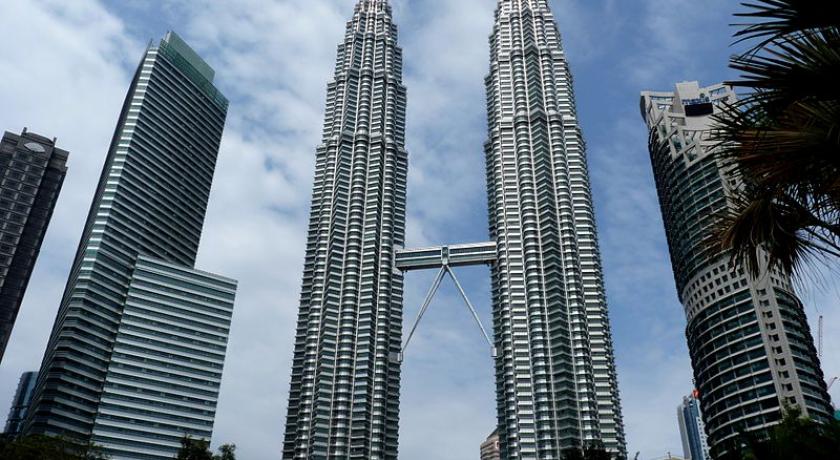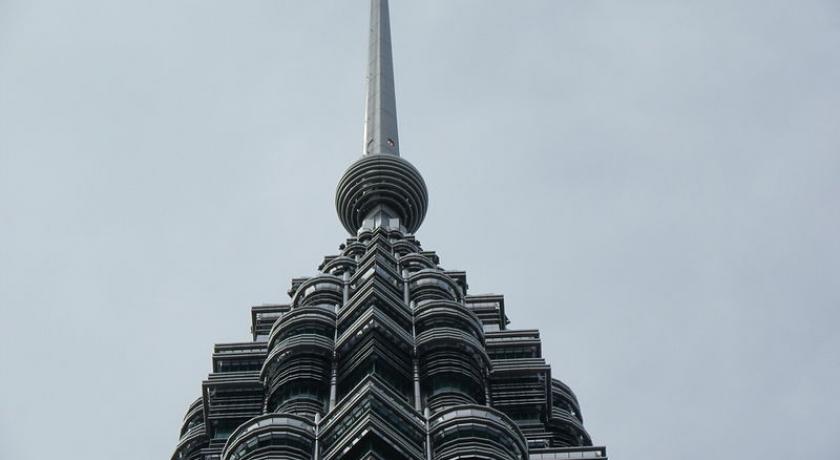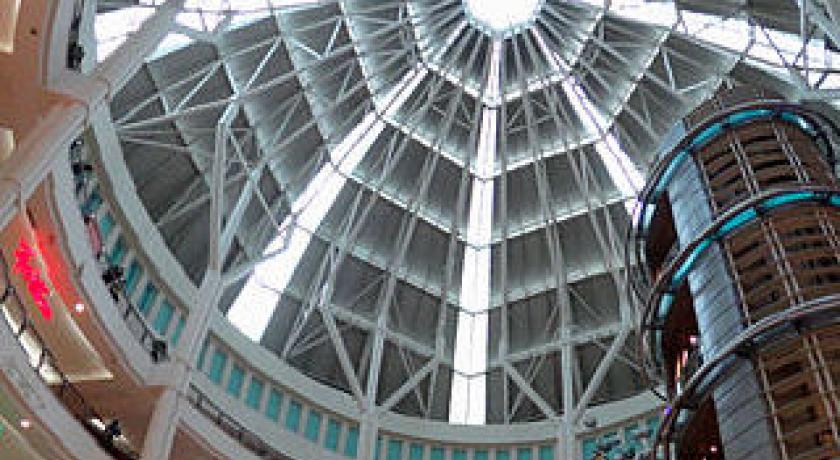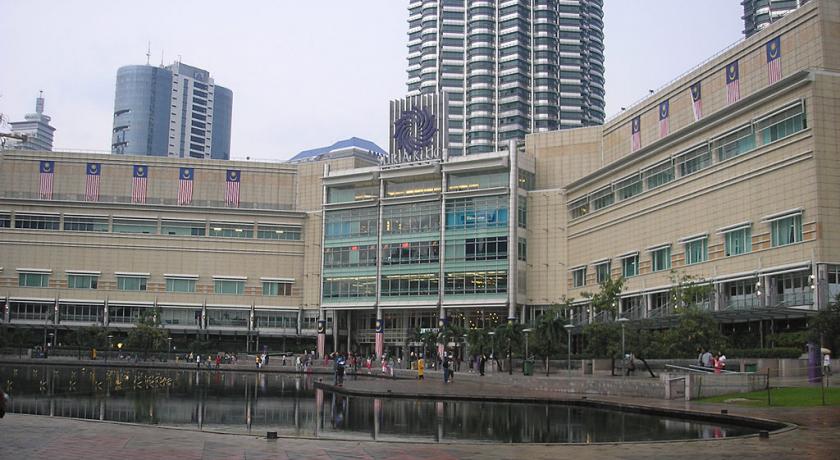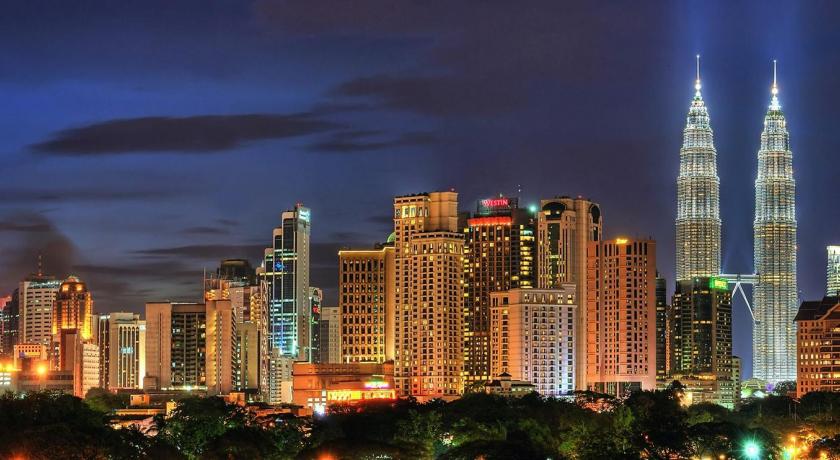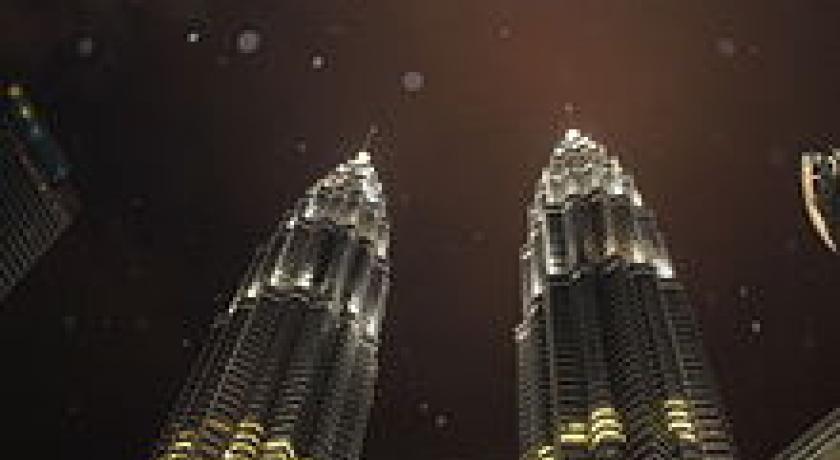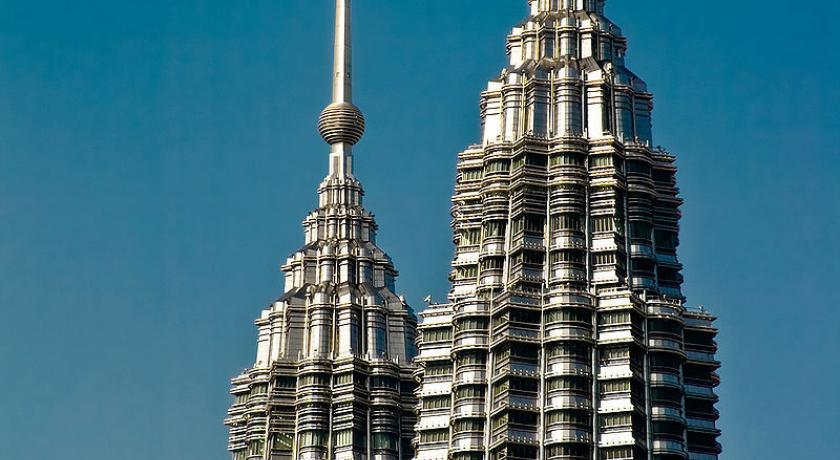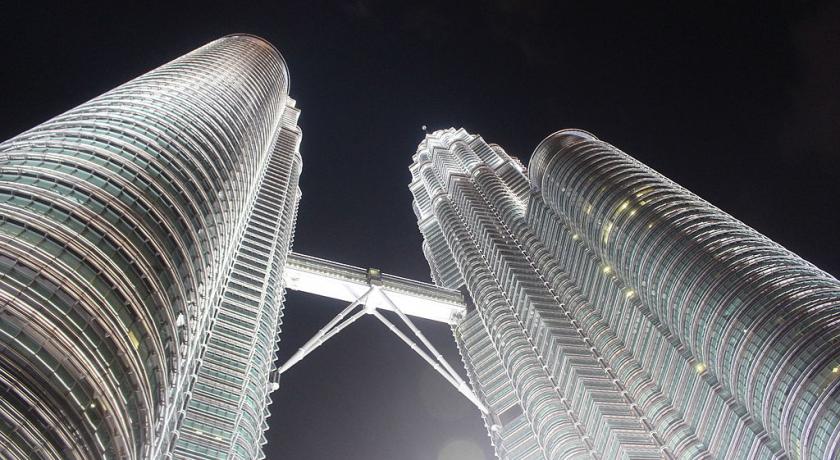Description
The Petronas Towers, also known as the Petronas Twin Towers (Malay: Menara Petronas, or Menara Berkembar Petronas), are twin skyscrapers in Kuala Lumpur, Malaysia. According to the Council on Tall Buildings and Urban Habitat (CTBUH)'s official definition and ranking, they were the tallest buildings in the world from 1998 to 2004 and remain the tallest twin towers in the world. The buildings are a landmark of Kuala Lumpur, along with nearby Kuala Lumpur Tower.
History
The towers were designed by Argentine architect César Pelli. They chose a distinctive postmodern style to create a 21st-century icon for Kuala Lumpur. Planning on the Petronas Towers started on 1 January 1992 and included rigorous tests and simulations of wind and structural loads on the design. Seven years of construction followed at the former site of the original Selangor Turf Club, beginning on 1 March 1993 with excavation, which involved moving 500 truckloads of earth every night to dig down 30 metres (98 ft) below the surface.
The construction of the superstructure commenced on 1 April 1994. Interiors with furniture were completed on 1 January 1996, the spires of Tower 1 and Tower 2 were completed on 1 March 1996, and the first batch of Petronas personnel moved into the building on 1 January 1997. The building was officially opened by the Prime Minister of Malaysia's Tun Dr. Mahathir bin Mohamad on 1 August 1999. The twin towers were built on the site of Kuala Lumpur's race track. Test boreholes found that the original construction site effectively sat on the edge of a cliff. One half of the site was decayed limestone while the other half was soft rock. The entire site was moved 61 metres (200 ft) to allow the buildings to sit entirely on the soft rock. Because of the depth of the bedrock, the buildings were built on the world's deepest foundations. 104 concrete piles, ranging from 60 to 114 metres (197 to 374 ft) deep, were bored into the ground. The concrete raft foundation, comprising 13,200 cubic metres (470,000 cu ft) of concrete was continuously poured through a period of 54 hours for each tower. The raft is 4.6 metres (15 ft) thick, weighs 32,500 tonnes (35,800 tons) and held the world record for the largest concrete pour until 2007. The foundations were completed within 12 months by Bachy Soletanche and required massive amounts of concrete. Its engineering designs on structural framework were contributed by Haitian engineer Domo Obiasse and colleagues Aris Battista and Princess D Battista. The Petronas Towers' structural system is a tube in tube design, invented by Fazlur Rahman Khan. Applying a tube-structure for extreme tall buildings is a common phenomenon.
The 88-floor towers are constructed largely of reinforced concrete, with a steel and glass facade designed to resemble motifs found in Islamic art, a reflection of Malaysia's Muslim religion. Another Islamic influence on the design is that the cross section of the towers is based on a Rub el Hizb, albeit with circular sectors added to meet office space requirements.
Due to the huge cost of importing steel, the towers were constructed on a cheaper radical design of super high-strength reinforced concrete. High-strength concrete is a material familiar to Asian contractors and twice as effective as steel in sway reduction; however, it makes the building twice as heavy on its foundation as a comparable steel building. Supported by 23-by-23 metre concrete cores and an outer ring of widely spaced super columns, the towers use a sophisticated structural system that accommodates its slender profile and provides 560,000 square metres of column-free office space. Below the twin towers is Suria KLCC, a shopping mall, and Dewan Filharmonik Petronas, the home of the Malaysian Philharmonic Orchestra.
Notable events
On 15 April 1999, Felix Baumgartner set the world record for BASE jumping (since broken) by jumping off a window cleaning crane on the Petronas Towers.
Thousands of people were evacuated on 12 September 2001 after a bomb threat was phoned the day after the September 11 attacks destroyed the World Trade Center towers in New York City. Bomb Disposal squads found no bomb in the Petronas towers but they evacuated everyone. Workers and shoppers were allowed to return three hours later, around noon. No one was hurt during the evacuation.
On the evening of 4 November 2005, a fire broke out in the cinema complex of the Suria KLCC shopping centre below the Petronas Towers, triggering panic among patrons. There were no reports of injuries. The buildings were largely empty, except the shopping mall, Suria KLCC, because of the late hour; the only people involved were moviegoers and some diners in restaurants.
On the morning of 1 September 2009, French urban climber Alain "Spiderman" Robert, using only his bare hands and feet and with no safety devices, scaled to the top of Tower Two in just under 2 hours after two previous efforts had ended in arrest. On 20 March 1997, police arrested him at the 60th floor, 28 floors away from the "summit". He made a second attempt on 20 March 2007, exactly 10 years later, and was stopped once again on the same floor, though on the other tower.
Comparison with other towers
The Petronas Towers were the tallest buildings in the world for six years, until Taipei 101 was completed in 2004. The height of the towers is measured to the top of their structural components such as spires, but do not include antennas. Spires are considered actual integral parts of the architectural design of buildings, to which changes would substantially change the appearance and design of the building, whereas antennas may be added or removed without such consequences. The Petronas Towers still remain the tallest twin buildings in the world.
The Petronas Towers feature a diamond-faceted facade consisting of 83,500 square metres (899,000 sq ft) of stainless steel extrusions. In addition, a 33,000-panel curtain wall cladding system resides within the towers. While the stainless steel element of the towers entices the illustrious sun, highlighting the magnificent towers, they are composed of 55,000 square metres (590,000 sq ft) of 20.38-millimetre (0.802 in) laminated glass to reduce heat by reflecting harmful UV rays.
On the top of each tower is a pinnacle standing 73.5 metres (241 ft) tall. The pinnacles were more than just the finishing touches to the height of the towers, each taking over 19 weeks to construct and both being assembled outside the country. One was constructed in Japan and the other in Korea. Each pinnacle is composed of 50 unique parts making up the main components: the spire, mast ball and ring ball. Together these parts weigh 176 tons. While the pinnacles may seem to be an aesthetic feature of the towers to enhance their presence and height, they also play function to aircraft warning lights and are an essential element to the overall Islamic minaret design that the towers embody.
The interiors of the towers highlight the Malaysian cultural inspiration to the design through traditional aspects such as fabric and carvings typical of the culture, specifically evident in the foyer of the entrance halls in the towers.
The construction of the Petronas Towers turned out to be a multinational effort. The structural design engineers worked out of New York City, while the wind-tunnel consultants and elevator design engineers were from Canada. To meet local safety construction codes, the towers had to be able to withstand 65 miles per hour (105 km/h) winds. To assure this requirement would be fulfilled, the engineers tested the towers twice within a wind tunnel, first by computer simulation and second by building an actual model of the towers.
Features
Suria KLCC is a 140,000 m2 (1,500,000 sq ft) upmarket retail center at the feet of the Petronas Towers. It features mostly foreign luxury goods and high-street labels. Its attractions include an art gallery, a philharmonic theatre, an underwater aquarium and also a Science center. Suria KLCC is one of the largest shopping malls in Malaysia.
KLCC Park
Spanning 17 acres (6.9 ha) below the building is the KLCC Park with jogging and walking paths, a fountain with incorporated light show, wading pools, and a children's playground.
Skybridge
The towers feature a double decker skybridge connecting the two towers on the 41st and 42nd floors, which is the highest 2-story bridge in the world. It is not attached to the main structure, but is instead designed to slide in and out of the towers to prevent it from breaking, as the towers sway several feet in towards and away from each other during high winds. It also provides some structural support to the towers in these occasions. The bridge is 170 m (558 ft) above the ground and 58 m (190 ft) long, weighing 750 tons. The same floor is also known as the podium, since visitors going to higher levels have to change elevators here. The skybridge is open to all visitors, but tickets are limited to about 1000 people per day, and must be obtained on a first-come, first-served basis. Initially, the visit was free but in 2010, the tickets started being sold by Petronas. Visitors can choose to opt for package one which is just a visit to the skybridge or go for package two to go to the skybridge and all the way to level 86. Visitors are only allowed on the 41st floor as the 42nd floor can only be used by the tenants of the building.
The skybridge also acts as a safety device, so that in the event of a fire or other emergency in one tower, tenants can evacuate by crossing the skybridge to the other tower. The total evacuation triggered by a bomb hoax on 12 September 2001 (the day after the September 11 attacks destroyed the twin towers of the World Trade Center in New York City) showed that the bridge would not be useful if both towers need to be emptied simultaneously, as the capacity of the staircases was insufficient for such an event. Plans thus call for the lifts to be used if both towers need to be evacuated, and a successful drill following the revised plan was conducted in 2005.
There is a two hinged arch that supports the skybridge with arch legs, each 51 metres (167 ft) long, that are bolted to level 29 of each of the towers. After being constructed on the ground, the skybridge was lifted into place on the towers over a period of three days in July 1995 but instead of being directly connected to the towers, the skybridge can shift or slide in and out of them to counterbalance any effect from the wind. Residing on the 41st and 42nd floors, the skybridge connects a conference room, an executive dining room and a prayer room.
Lift system
The main bank of Otis Lifts is located in the centre of each tower. All main lifts are double-decker with the lower deck of the lift taking passengers to even-numbered floors and upper deck to odd-numbered floors. To reach an odd-numbered floor from ground level, passengers must take an escalator to the upper deck of the lift.
Apart from this main bank of lifts, there are a series of "connecting" lifts to take people between the groups. Unlike the main lifts, these are not the double-decker type. Two lifts are provided to take people from levels 37/38 to levels 41/42 (levels 39 and 40 are not accessible as office space). This spares someone in the lower half of the building from having to go back to the ground floor to go to the upper half of the building.
The lifts contain a number of safety features. It is possible to evacuate people from a lift stuck between floors by manually driving one of the adjacent lifts next to it and opening a panel in the wall
Ticketing System
In order to visit Petronas towers, visitors must first purchase the tickets. Tickets of adults and children can be purchased via online web portal or at the counter. Discounted tickets for seniors are available for those 55 years of age and above. Queues for tickets can get quite long sometimes. The complete Ticketing System or Automated Fare Collection system is provided by a Malaysian-based solution company called Longbow Technologies Sdn Bhd.
In popular culture
The towers are prominently featured and mentioned by name in the 1999 film Entrapment, with numerous scenes filmed at the towers, with the climax set on the skybridge.
The Towers appear in the first episode of the US TV series 24.
Several scenes of the Bollywood film Don: The Chase Begins Again were also filmed in the Petronas Towers and its skybridge.
In the Phineas and Ferb episode "Phineas and Ferb Save Summer!", the towers are visible during the musical number "Summer All Over the World".
Eidos Interactive has twice used the towers for inspiration in their video games. In the 2002 Hitman 2: Silent Assassin, the Malaysia-based levels Basement Killing, The Graveyard Shift, and The Jacuzzi Job all take place in the Petronas Towers. In 2010's Just Cause 2, the fictional Panau Falls Casino is based on the Petronas Towers.
A 2002 episode of the animated seriesJackie Chan Adventures titled "When Pigs Fly" (Season 3, Episode 6), features the towers.
The towers made its appearance, in the animated series Totally Spies episode titled "Man or Machine".
The opening of the 2010 film Fair Game had scenes with the twin towers along with the skyline of Kuala Lumpur.
A number of scenes for the 2012 Hong Kong-Chinese action film Viral Factor included shots of the twin towers.
In the 2016 movie "Independence Day Resurgence", the towers are seeing being thrown against the London Tower Bridge by aliens, with a character saying: "They like to get the landmarks".
Address
Kuala Lumpur
Malesia
Lat: 3.157807589 - Lng: 101.711616516


